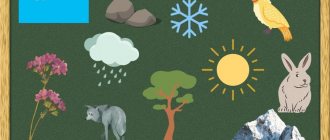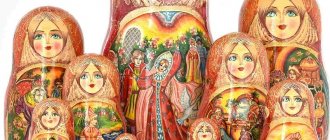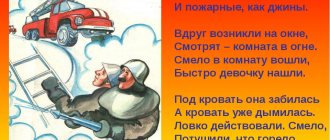Summary of an ecology lesson on the topic “The importance of the sun in our lives”
For middle group children
Program content. To draw children's attention to the constant presence of the sun, warmth, light in our human lives, to evoke an emotional attitude towards the sun, to its role in the life of humans, birds and animals. To acquaint children with the behavioral and visual characteristics of animals living in conditions of lack of light or in the complete absence of light. Give first ideas about environmental protection.
Material and equipment. A thick blanket, a painted sun, a figurine of a person, a table lamp, a bag with various dry herbs, various small objects, mirrors for each child, musical accompaniment.
Progress of the lesson.
What is the weather today: sunny or cloudy. Is the sun shining? What mood do children have in sunny weather and what in cloudy weather? Psycho-gymnastics “Sunny - Cloudy” is carried out
Why do we need the sun? What does it do for us? /warms, shines/. Where does the sun go in the evening? What do we do at night? Where does the sun come from in the morning? /wakes up/.
Game "Day - Night". At the teacher’s command, it’s night / the children fall asleep /, at the command of day, they wake up.
What would happen if the sun went to sleep and never returned? /frozen/. Psycho-gymnastics “Cold”.
To feel how we would live without sunlight, we need to be in complete darkness. To play, take a thick blanket, children sit on the floor and cover themselves with the blanket. What do they see? Day comes, the blanket is removed, and sunlight helps children distinguish objects. Why couldn't children see, because they have eyes? A person sees when he has light. If there were no light, then we would not need eyes.
How does the sun get through our window? That he has? /rays/. Do you want to play with a ray of sunshine? How can you play with the beam? You can catch him. How? /mirror/. The teacher catches a ray of sunshine with a mirror, invites the children to catch the ray, /what is a ray of sunshine?/ what is a sunbeam? A ray of sunshine is reflected from the mirror and turns into a sunbeam. The game “sun bunnies” children turn into sun bunnies and flutter like sun bunnies to the accompaniment of music.
Who else besides humans needs the sun? /animals/, Why? But there are animals that see in the dark. Who is this? /cat, owl/, How do they hunt? Game "Animals in the Dark". The child is blindfolded, the teacher gives an object into his hands and asks him to guess what exactly he received. It is advisable for the item to have a scent, /it can be dried grass, fresh pine cone, lemon or apple/. Being in the dark, the child will try to blindly identify the proposed object. How will he do this? Touch the object with your hands, stroke it, turn it, smell it.
After the children identify objects in the dark, the teacher discusses with them how they did it. Did they need eyes? But there are animals that live where there is practically no light. For example: underground in deep caves, at the bottom of the ocean. Indeed, their eyes turn into small slits /mole/.
Who else needs sunlight? /plants/. What happens if a plant falls into complete darkness? /will die/. The teacher demonstrates a plant that grew in the dark and a plant that grew in the light. Children find the difference in the color of the plant. They draw a conclusion.
Where can the sun go? /night, cloud, smoke/. What should we do to prevent the sun from disappearing? /children answer/. In the meantime, we are friends with the sun.
Psycho-gymnastics “Solar warmth” is carried out. To the accompaniment of calm music, children expose their faces to the sun, close their eyes, and relax.
In order for children to clearly understand how the sun is covered by a cloud and a shadow falls on a person, an experiment is carried out. Take a burning table lamp, a small man, and insert a flat circle between them. A shadow appears on a person.
Summary of a conversation with children from the “Sun” middle group
municipal government preschool educational institution "Kindergarten No. 24" of the Yemanzhelinsky municipal district of the Chelyabinsk region
Summary of a conversation with children from the “Sun” middle group
Author:
Belyaeva E.A.
Target:
Give children an idea of the Sun
Educator:
Guys, guess the riddle:
This yellow bright ball
Gives light and warmth to us all
Children's answers:
Sun
Educator:
That's right, it's the sun. Tell me, what shape is the sun?
Children's answers:
Ball, circle
Educator:
The sun is spherical, just like our planet. What do you think the sun is?
Children's answers:
Planet, star
Educator:
Guys, the sun is a star, the main star for all life on earth, without the sun our life on earth would not be possible. And why?
Children's answers:
It will be dark and cold
Educator:
Yes, the sun gives us warmth and light, without the sun the plants that animals and people eat cannot grow, without the sun’s heat and light there would only be cold on earth. The sun's rays also give everyone vitamin D, it is very important, its deficiency can cause illness.
The sun was born from a cloud of dust and gas very 5 billion years ago. People who lived a very long time ago and did not know anything about the cosmos thought that the sun was God, they were afraid of him, they worshiped and offered gifts so that the sun would be kind to them.
Guys, we talked about the fact that there are 8 planets in our solar system and they all revolve around the sun. That's why our system is called solar.
Let's remember the chants we use to invite the sun.
Children:
Red, gear up! Hurry up, don’t be timid, warm us guys up!
Bucket sun, come out from behind the bald spot. Sit on a tree stump and walk all day.
Bake, bake, sunshine, red bucket! Play early and early, keep your kids warm! Your children are crying, jumping on the pebbles!
Educator:
Guys, the sun is very hot, and it is not possible to get to it, there are spots in the sun - these are places where the temperature is a little colder and therefore they have darker colors.
The teacher suggests looking at the illustrations.
Educator:
Guys, despite the fact that the sun is important for life, it can be dangerous. Tell me, why is the sun dangerous?
Children's answers:
You might get burned
Educator:
Guys, if you stay in the sun for a long time, your skin can get burned. Sunstroke may also occur. What needs to be done to avoid such troubles?
Children's answers:
Wear a cap and do not sit in the sun for long periods of time.
That's right, if you follow the rules on hot days, then everything will be fine. It is better to sunbathe in the morning, wear a Panama hat or cap during the day, drink more water, and do not sit in the sun for long. This is how much interesting we learned about the sun.
Summary of the lesson “Sun, air and water are our faithful friends” in the senior group
Notes for a lesson on ecology “The sun, air and water are our faithful friends” for children in the senior group
Description of the material: notes for a lesson in mathematics have been prepared for children in the senior group. Direct educational activities are aimed at expanding the knowledge of preschool children and developing skills in various types of activities. This summary may be of interest to both teachers of preschool educational organizations and students studying in the specialty “Preschool Education”. Group: senior. Goal: to consolidate and expand children’s ideas about the role of the sun, air and water for the whole Earth. Didactic objectives: to help expand children's knowledge about the properties of air, water and the sun, their role for plants, animals and humans; Promote the understanding that fresh air, clean water and sufficient light are essential to health. Developmental tasks: to promote the development of thinking, imagination, memory, attention, the ability to conduct simple experiments;
help expand children's vocabulary. Educational objectives: create conditions for instilling respect for water and air; fostering interest in simple experiments; fostering friendship in the group. Equipment: pictures of a dirty globe, a letter, a balloon, cups of water, straws, a globe, a card with a riddle, “tickets.” GCD move
Introductory and organizational part
Educator: Guys, we received a letter in our group. It's from Dunno. Let's read it. (Reading the letter)
“Dear friends!
Recently, my friend Donut and I flew to the moon. At first we wanted so much to stay and live on the Moon, no one teaches you, no one teases you, walk as much as you want. But soon we got bored. You can only walk in spacesuits and eat from tubes. And even the seeds of the plants that we brought to the Moon cannot be grown. No, living on Earth is more pleasant. I sent you a riddle. If you guess correctly, you will become members of the Young Knows club. The riddle will make it clear what we cannot live on Earth without.” Well, let's guess the riddle? Children: Yes.
Main part
Educator: You warm the whole world And you don’t know fatigue, You smile in the window And everyone calls you... Children: The sun. Educator: Correct! Guys, why is the sun needed? Children: The sun is a source of light and heat. It warms. Gives warmth. Educator: And to whom does it give its warmth? Children: Animals, plants, people. Educator: That's right Guys, we recently planted onions with you. Let's take a look at it. We will compare onions from the windowsill and onions that were left in the closet. What happened to him? Children: That onion that stood in the sun sprouted and gave plump green sprouts. And the one that was in the closet is just beginning to sprout and the tips of its sprouts are yellow. Educator: Why do you think there is such a difference? Children: Because one stood in the light and the other in the dark. Educator: That's right! From this experience we can say that plants need light and warmth in order to live. Can we live without light and solar heat? What will happen to us? Children: It will get cold, we will freeze and get sick. It will always be dark. Educator: Yes, of course! Tell me, what do we like to do in the sun in the summer? Children: Sunbathe, warm up, play. Educator: Yes. The sun makes everyone feel bright, happy and warm. And now summer is coming to us. What's the sun like in summer? Children: Tall, bright, hot. Educator: That's right!
In summer, the sun's rays hit the Earth at right angles, so summer is always bright and warm. Now let's get up and stretch a little. Physical exercise “Sun”
Educator: A sunflower grows in the yard, In the morning it reaches for the sun. (Children stand on their tiptoes and stretch their arms up)
Next to him is a second one, similar, He, too, is reaching for the sun.
We turn the handles in a circle. Don't accidentally hit your friend! A few circles forward, and then vice versa. (Rotation of straight arms forward and backward)
We had a wonderful rest, And it’s time for us to sit down.
Educator: Well done, sit down on the chairs. Don't forget to sit upright and keep your backs straight. Guys, as you noticed, the letter will arrive to us in a balloon. Tell me, what's inside the ball? Children: Air. Educator: Yes. Why do we need air? Children: We breathe it. Educator: Let's now try to close our mouth and pinch our nose with our fingers, how long can we hold out without air? Children: No. Educator: That's right! And as you rightly said, in order to live, we need to constantly breathe air. Who else needs air to live? Children: Plants, animals. Educator: Correct! Air surrounds our entire Earth; people, animals and plants breathe air. Tell me, guys, is it possible to see air, hear it or touch it? Children: No. Educator: When can we see air? Children: When it is in a balloon or outside in the cold, when we exhale warm air through our mouths, we see steam. Educator: That's right, well done! Each of the vases has a glass of water and a straw on the table. Let's breathe into the tube. What appeared in the glass? Children: Air bubbles. Educator: Yes. This means that we can see the air itself only with the help of something: a ball, or when we blow from a tube into water. How can we feel the air? Bring your palm to your mouth and blow on them. Can you feel the air? Children: Yes. Educator: How can we feel the air on the street? Children: Yes, when the wind blows. Educator: Correct. Wind is also air that moves. We conclude: we can feel air when the wind blows, or when we blow on our palms. Now let's try to hear the air. To do this, I will inflate the balloon and slowly release the air from it. What do we hear? Children: Hissing, whistling. Educator: That's right. This means we can hear him. Let's summarize. Air itself cannot be felt, seen or heard. But we can do all this with the help of different objects, as we did now. Now tell me how air affects our health? Children: Clean air protects against diseases. But polluted water is harmful to health. Educator: Good guys! Where can we see dirty air? Children: Black smoke from chimneys, exhaust gases from cars (I accompany the children’s answers with pictures). Educator: What will happen to humans and animals if we breathe dirty air? Children: You can get sick. Educator: Yes. The best healer for the air is trees. They purify the air, so it is always easy to breathe in the forest. A person plants trees around houses, creates parks, groves, squares - everything so that people can breathe easier and people get sick less. Now let's play with the ball a little. (Children stand in a circle, say a poem about a ball and pass it on. Whoever ends the poem says his name)
.
You roll, funny ball, quickly and quickly through your hands. Whoever has a funny ball will tell us the name. Educator: Well done, sit down on the chairs. Keep your backs straight. Look, Dunno also sent a bottle. What's inside? Children: Water. Educator: Yes, this is water. Do you think a person can live without water? Children: No. Educator: That's right, he can't. Who else needs water? Children: Plants and animals. Educator: Yes. Is it possible to drink water from the sea or ocean? Children: No. Educator: Why? Children: It is very salty and dirty. Educator: What kind of water can you drink? Children: Clean, tasteless and odorless. Educator: That's right, well done. Where does fresh water come from? Children: From rivers, streams and underground sources. Educator: Absolutely right. Guys, look at the globe. This is a small scale model of our Earth, with a lot of blue on it. This is indicated by water! There is a lot of water on our planet, but not all water is drinkable. There is a lot of salty, but not enough fresh. If there is not enough of it, what should you do? Children: Take care. Educator: Yes, you need to save water. How can we save it? Children: Close the taps, take as much water as you need, protect it. Educator: What to protect from? Children: From pollution. Educator: Yes, that's right.
Do not throw garbage into water bodies or pour out various chemicals. The water will be poisoned. And if it is poisoned, the fish will die, the animals will become infected, and then humans will become infected. Final part
Educator: So, today we learned three important factors for life. These are sun, air and water. Without them there will be no life on earth. A ray of sunshine makes us laugh and teases us, We are having fun this morning. And with us everywhere our best friends are: Sun, air and water! Educator: Today you answered questions very actively and gave the correct answers. And I can proudly present you with the tickets for the participants of the “Young Knows” club, which Dunno sent (I take out the tickets and hand them to the child)
.
We recommend watching:
Abstract of OOD in the senior group. Environmental education Notes on ecology in the senior group "Young laboratory assistants" Lesson summary - traveling on ecology in kindergarten in the senior group Notes on ecology in the senior group on the topic: "Meadow ecosystem"
Similar articles:
Lesson summary on the topic “Reserve” in the senior group
Summary of a lesson on familiarization with the environment in the senior group of kindergarten. Topic: “Birds of different countries”
Summary of a lesson on ecology in the senior group on the topic: Sea inhabitants
Lesson summary for the senior group on the topic: Insects and flowers
Lesson notes on ecology in the senior group of kindergarten





